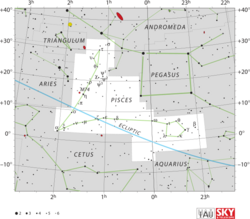Astronomy:Kappa Piscium
| Observation data Equinox J2000.0]] (ICRS) | |
|---|---|
| Constellation | Pisces |
| Right ascension | 23h 26m 55.95586s[1] |
| Declination | +01° 15′ 20.1900″[1] |
| Apparent magnitude (V) | 4.94[2] |
| Characteristics | |
| Spectral type | A2 Vp SrCrSi[3] |
| U−B color index | −0.03[2] |
| B−V color index | +0.04[2] |
| Variable type | α2 CVn[4] |
| Astrometry | |
| Proper motion (μ) | RA: +86.68[1] mas/yr Dec.: −94.29[1] mas/yr |
| Parallax (π) | 21.25 ± 0.29[1] mas |
| Distance | 153 ± 2 ly (47.1 ± 0.6 pc) |
| Absolute magnitude (MV) | +1.59[5] |
| Details[6] | |
| Mass | 2.62 M☉ |
| Radius | 1.86[7] R☉ |
| Luminosity | 30[8] L☉ |
| Surface gravity (log g) | 4.46 cgs |
| Temperature | 10,961±373 K |
| Metallicity [Fe/H] | +0.74[5] dex |
| Rotational velocity (v sin i) | 34 km/s |
| Age | 157 Myr |
| Other designations | |
| Database references | |
| SIMBAD | data |
Kappa Piscium (κ Piscium) is a solitary,[10] white-hued star in the zodiac constellation of Pisces. It is visible to the naked eye with an apparent visual magnitude of 4.94,[2] forming the southeastern corner of the "Circlet" asterism in Pisces. Based upon a measured annual parallax shift of 21.25 mas as seen from Earth,[1] it is located about 153 light years distant from the Sun. Appearing as a single point in the sky, it is easily split when viewed with a pair of binoculars, and displays three components. Kappa Piscium has an apparent magnitude of 4.87 at maximum brightness and 4.95 at minimum brightness,[4] while the visual companions have apparent magnitudes of 9.96 and 11.20.[11]
This is an A-type main-sequence star with a stellar classification of A2 Vp SrCrSi.[3] The suffix designation indicates it is a "chemically peculiar" Ap star[7] that displays abnormal abundances of silicon, strontium, and chromium. It is an Alpha2 Canum Venaticorum variable[4] with a weak[7] active magnetic field that causes it to fluctuate by 0.01 to 0.1 in magnitude as it rotates. It shows many lines of uranium, and possibly the rare element holmium in its spectrum. Its uranium and osmium content could have been provided by a nearby supernova.[13] Compared to the Sun, it is deficient in oxygen relative to the magnesium abundance.
This star is a candidate member of the AB Doradus moving group, an association of stars with similar ages that share a common heading through space.[8]
Naming
In Chinese, 雲雨 (Yún Yǔ), meaning Cloud and Rain, refers to an asterism consisting of refers to an asterism consisting of κ Piscium, 12 Piscium, 21 Piscium and λ Piscium. Consequently, the Chinese name for κ Piscium itself is 雲雨一 (Yún Yǔ yī, English: the First Star of Cloud and Rain.)[14]
References
- ↑ 1.0 1.1 1.2 1.3 1.4 1.5 van Leeuwen, F. (2007), "Validation of the new Hipparcos reduction", Astronomy and Astrophysics 474 (2): 653–664, doi:10.1051/0004-6361:20078357, Bibcode: 2007A&A...474..653V.
- ↑ 2.0 2.1 2.2 2.3 Johnson, H. L. et al. (1966), "UBVRIJKL photometry of the bright stars", Communications of the Lunar and Planetary Laboratory 4 (99): 99, Bibcode: 1966CoLPL...4...99J.
- ↑ 3.0 3.1 Abt, Helmut A.; Morrell, Nidia I. (1995), "The Relation between Rotational Velocities and Spectral Peculiarities among A-Type Stars", Astrophysical Journal Supplement 99: 135, doi:10.1086/192182, Bibcode: 1995ApJS...99..135A.
- ↑ 4.0 4.1 4.2 Samus, N. N. et al. (2017), "General Catalogue of Variable Stars", Astronomy Reports, GCVS 5.1 61 (1): 80–88, doi:10.1134/S1063772917010085, Bibcode: 2017ARep...61...80S.
- ↑ 5.0 5.1 Anderson, E.; Francis, Ch. (2012), "XHIP: An extended hipparcos compilation", Astronomy Letters 38 (5): 331, doi:10.1134/S1063773712050015, Bibcode: 2012AstL...38..331A.
- ↑ David, Trevor J.; Hillenbrand, Lynne A. (2015), "The Ages of Early-Type Stars: Strömgren Photometric Methods Calibrated, Validated, Tested, and Applied to Hosts and Prospective Hosts of Directly Imaged Exoplanets", The Astrophysical Journal 804 (2): 146, doi:10.1088/0004-637X/804/2/146, Bibcode: 2015ApJ...804..146D.
- ↑ 7.0 7.1 7.2 Glagolevskij, Yu. V. et al. (October 2006), "Spectroscopic study of the weak magnetic star HD220825-κPsc", Astrophysics 49 (4): 497–505, doi:10.1007/s10511-006-0048-5, Bibcode: 2006Ap.....49..497G.
- ↑ 8.0 8.1 McCarthy, Kyle; White, Russel J. (June 2012), "The Sizes of the Nearest Young Stars", The Astronomical Journal 143 (6): 14, doi:10.1088/0004-6256/143/6/134, 134, Bibcode: 2012AJ....143..134M.
- ↑ "kap Psc". SIMBAD. Centre de données astronomiques de Strasbourg. http://simbad.u-strasbg.fr/simbad/sim-basic?Ident=kap+Psc.
- ↑ Eggleton, P. P.; Tokovinin, A. A. (September 2008), "A catalogue of multiplicity among bright stellar systems", Monthly Notices of the Royal Astronomical Society 389 (2): 869–879, doi:10.1111/j.1365-2966.2008.13596.x, Bibcode: 2008MNRAS.389..869E.
- ↑ Mason, B. D. et al. (2014), "The Washington Visual Double Star Catalog", The Astronomical Journal 122 (6): 3466–3471, doi:10.1086/323920, Bibcode: 2001AJ....122.3466M.
- ↑ "MAST: Barbara A. Mikulski Archive for Space Telescopes". Space Telescope Science Institute. https://mast.stsci.edu/portal/Mashup/Clients/Mast/Portal.html.
- ↑ Jørgensen, Christian K. (March 1, 2005), "Heavy elements synthesized in supernovae and detected in peculiar A-type stars", Noble Gas and High Temperature Chemistry, Structure and Bonding 73: pp. 199–226, doi:10.1007/3-540-52124-0_4, ISBN 978-3-540-52124-2.
- ↑ (in Chinese) AEEA (Activities of Exhibition and Education in Astronomy) 天文教育資訊網 2006 年 7 月 8 日
 |



